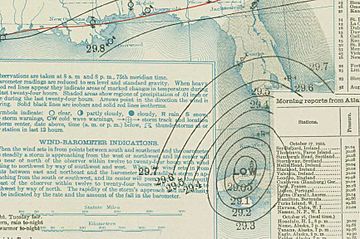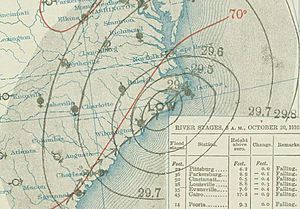1910 Cuba hurricane facts for kids
| Category 4 major hurricane (SSHWS/NWS) | |

Map of the storm on October 10
|
|
| Formed | October 9, 1910 |
|---|---|
| Dissipated | October 23, 1910 |
| Highest winds | 1-minute sustained: 150 mph (240 km/h) |
| Lowest pressure | 924 mbar (hPa); 27.29 inHg |
| Fatalities | ≥113 |
| Damage | $-199,999,900 (1910 USD) |
| Areas affected | Cuba, Florida |
| Part of the 1910 Atlantic hurricane season | |
The 1910 Cuba hurricane was one of the worst tropical storms to ever hit Cuba. It started in the southern Caribbean Sea on October 9, 1910. The storm grew stronger as it moved northwest. It then hit the western part of Cuba.
After hitting Cuba, the storm made a strange loop over the ocean. Then, it started moving towards the United States. It crossed Florida and moved near the southeastern United States before going out to sea.
Because of its unusual loop, some people thought it was actually two different hurricanes. In Cuba, this storm caused huge damage. Thousands of people lost their homes. In Florida, the storm also caused damage and flooding in some areas. The exact cost of damage is not known. However, in Havana, Cuba, losses were over $1 million. At least 100 people died in Cuba alone, but some reports say the number was much higher.
Contents
How the Storm Formed and Moved
On October 9, a small storm called a tropical depression began. It was in the southern Caribbean Sea, north of Panama. This storm got stronger as it moved northwest. It became a tropical storm on October 11. By October 12, it had turned into a full hurricane.
The next day, the hurricane was southwest of Cuba. For a short time, it became a very strong Category 3 hurricane. This is measured on the Saffir–Simpson Hurricane Scale. The storm then hit western Cuba and moved across the island. It then went over the Gulf of Mexico and slowed down.
An area of high pressure (a type of weather system) to the north guided the hurricane. Over the warm waters of the Gulf of Mexico, the hurricane quickly became much stronger. It then moved in a small circle. On October 16, it reached its strongest point. Its winds were blowing at 150 mph (240 km/h).
The hurricane then turned northeast and hit western Cuba again. It started moving near the Florida Panhandle on October 17. The storm hit Cape Romano, Florida, and moved north. Once it was over land, the hurricane became weaker. After crossing Florida, it curved northeast and went into the Atlantic Ocean. The storm likely ended on October 23.
This storm was unusual because people first thought it was two different hurricanes. This was because of the loop it made in the Gulf of Mexico. One newspaper even said the first hurricane died, and a second one formed and hit Florida. But after much discussion, it was later confirmed to be just one storm.
What Happened During the Storm
On October 15, all ships within 500 miles (800 km) of Key West were warned about the storm. Many ships stayed safely in harbors. Storm warnings were also put out for people on land.
Impact in Cuba
The hurricane caused terrible damage in Cuba. It was one of the worst tropical storms the island had ever seen. Strong winds and heavy rain caused streets to flood. It ruined crops, especially tobacco, and damaged farms. Many towns were affected, including Casilda. The town of Batabanó was completely covered in water. The hurricane also stopped all communication to other areas. Most of the deaths and damage happened in the Pinar del Río Province.
The New York Times wrote that Cuba had "probably suffered the greatest material disaster in all its history." Thousands of peasants, or farm workers, lost their homes. The country's capital, Havana, also suffered bad damage. On the coast, many ships carrying valuable items sank. The storm also badly damaged goods stored on wharves. Huge waves crashed onto land and caused flooding. Many boats were destroyed. The high waves flooded about 1 square mile (2.6 km2) of Havana's coastal area.
At least 100 people were killed by the storm. Most deaths were from mudslides, including five people in Havana. However, some reports say the total number of deaths was as high as 700. The storm caused millions of dollars in damage. In Havana alone, $1 million in losses were reported.
The Ship Holliswood
A ship named the Holliswood got caught in the storm in the Gulf of Mexico. It had left New Orleans on October 1, carrying cypress wood. The ship's crew fought the storm for many days. The Holliswood was blown miles off its planned path. Its owner, Paul Mangold, described the experience:
On Wednesday, the 12th, we began to get the first of the hurricane. [...] Early Saturday morning we got the full force of the storm. [...] The wind circled about us sometimes at a hundred-mile rate. The seas came from all directions, though it was from the starboard [right side] that the real trouble seemed to come.
Another ship, a steamboat called the Harold, saw the Holliswood. It rescued all of the crew. However, Captain E. E. Walls wanted to stay behind. The Holliswood was badly damaged. The crew told the captain the ship would sink in five more hours. After the crew was rescued, Captain Walls struggled for days without food or fresh water. On October 20, another ship, the Parkwood, rescued Walls. He was unconscious and seemed to be dead. But when he was on the Parkwood, he woke up. He was confused and asked to be put back on the Holliswood. Instead, the Parkwood pulled the damaged ship to land.
Impact in Florida
In Key West, Florida, winds blew at 110 mph (177 km/h). Many docks were destroyed. Damage in the Florida Keys was about $250,000 in 1910 money. This would be about $5.7 million today. Houses near the ocean were also damaged. Strong winds pushed water out of Tampa Bay. High waves from the sea moved over land, and people had to hold onto trees to survive. Some citrus crops were destroyed. The wind tore roofs off homes and shook buildings off their foundations.
Seven men died at Punta Gorda, Florida when some Cuban ships were wrecked. Near there, one man and a baby drowned. Another person died trying to cross a flooded river. A French steamship, the Louisiane, crashed into land. There were 600 passengers on this ship. Luckily, another ship rescued everyone.
The hurricane blew down many pine trees near Jupiter, Florida. One man near Lemon City was killed by falling wood. However, the storm's effects on the east coast of Florida were not as bad as in other places. Part of the Florida East Coast Railroad was washed away. The storm blew an American ship aground at Boca Raton, Florida. Three people died, and the rest of the crew were stuck for 12 hours.
Related pages
|
Tropical cyclones of the 1910 Atlantic hurricane season |
|||||||||||||||||||||
|
|
||||||||||||||||||||
|
|
|||||||||||||||||||||
Images for kids
See also
 In Spanish: Huracán de Cuba de 1910 para niños
In Spanish: Huracán de Cuba de 1910 para niños




